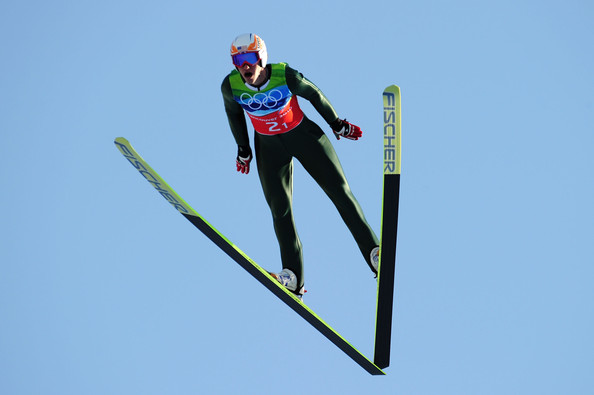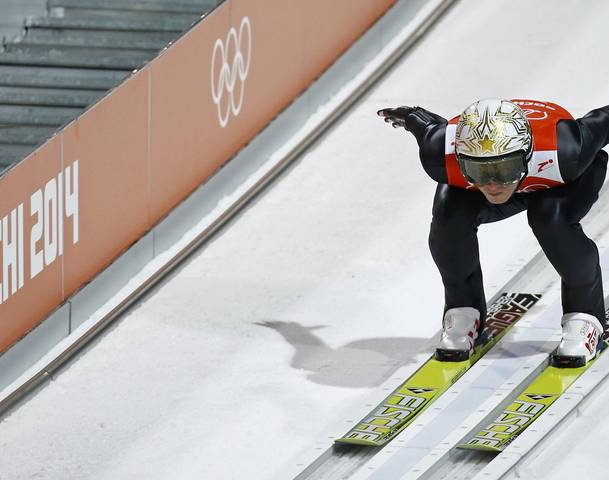Conor Walsh | Staff Writer
As will become quite apparent over the course of the Sochi Games, the Winter Olympics doesn’t tend to do things by halves. Whereas the its summertime equivalent hosts numerous spectacles designed to showcase the very best humankind has to offer in terms of athletic prowess and physical and mental strength and endurance, the Winter Olympics tend to be set up in a way which is designed to offer the same principles coupled with the remarkable skill of allowing oneself to put their life at risk. This is not just limited to the speed events of Alpine skiing, as was alluded to in a previous article.
Earlier this year on the Kulm Ski Jumping Hill in Tauplitz-Bad-Mittendorf, Austria, three times Olympic champion Thomas Morgenstern was hurtling down the in-run to the hill at over 100 km/h. After he had executed his jump from the edge of the platform, a slight loss of control led to him plummeting into the steep slope below, and, with the back if his head smashing the snow on impact and a subsequent roll down a 100 metre hill, he was left with a skull fracture and lung damage. Add to this the injuries he received at a meet two months prior to that and one would surely write off his chances of competing in February’s showpiece. Such is the nature of this sport that it was announced that Morgenstern would be part of the Austrian Olympic team come the start of the Games.
This article doesn’t aim to portray ski jumping as some gruesome bloodsport designed turn viewers off it in disgust. Crashes and debilitating injury thankfully do not occur very often. Safety precautions are such that if winds are inconsistent or blowing in the wrong direction – usually sharply from side- to-side – then jumping tournaments are postponed and in some cases even abandoned. When it does take place though, I can think of no other sport where extreme precision and timing is of such paramount importance. It isn’t, after all, just about jumping further than your opponents.
To start with, the ski jumper must propel themselves down a steep slope on skis nearly one and a half times their height – for a six foot jumper that means skis over eight feet long – bringing them up to a speed well in excess of 80 km/h. The typical World Cup hill averages around the 140 metre mark, which the length of most Olympic hills is; however the normal hill, usually 90 metres in length, is also contested at the Olympics. Once they reach the platform at the end of this slope they must time their jump immaculately and with the requisite power to hurl them into the air. Thereafter, the landing is becomes all important.
It’s not enough just to jump and land on any given section of the hill. On each one there is a calculation line (or K point): on a 140 metre hill this usually resides around the 120 mark. Landing on the calculation line will result in the jumper receiving 60 points. Jumping further than this gives the jumper bonus points of 1.8 per metre gained on a large hill or 2 points for a small hill, with the same values deducted if one should fall short of the mark. This isn’t the end of the scoring though. Nestled on high in the stadium somewhere is situated a panel of five judges who grade the jumper’s landing. Each member of the panel awards 20 marks for the degree of difficulty which a skier lands with: the most difficult landing by far is what’s known as the telemark, a position whereby the jumper will adopt a genuflected position with his legs based on the type of backcountry skiing popular in the Nordic countries. The best and worst marks are deducted, with the style marks added to the distance points. To make matters a little more difficult, if one falls on landing they score nothing.
The complexity, then, of this sport is not just confined to the jumpers partaking in it; the spectator is wont to be comfortable with numbers if they are to keep up with the unfolding events. This doesn’t stop it being one of the most popular sports in Austria and, its country of origin, Norway. Austria in particular have a history of success in the Olympics with their current squad of Schlierenzauer, Diethart, Kofler and Morgenstern all in contention for gold. The resurgent Swiss sensation Simon Ammann is vying for fifth gold medal having previously dominated the Salt Lake City and Vancouver Games. An outside shout for men’s gold is the eternal athlete Noriaki Kasai of Japan, who at the grand old age of forty one became the oldest man to win a regular season event this year. The ski jumping competition promises to be as exciting as it is perilous. For many spectators, and especially the fortunate few who will witness this spectacle in the flesh, it is a unique opportunity to observe man come as close to flying majestically like eagles, only without wings.








